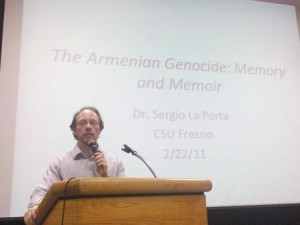Staff Report

Photo: ASP Archive
On February 22, Dr. Sergio La Porta lectured at Sonoma State University (SSU) as part of the 28th Annual Holocaust Lecture Series organized by the Center for the Study of the Holocaust and Genocide of SSU and the Alliance for the Study of the Holocaust and Genocide. Dr. La Porta participated in the same series last year and was very pleased and honored to be asked to return.
The theme of this year’s lecture series was “Remembering and Preserving Memory” and there were over one hundred students, faculty, and community members present. Dr. La Porta’s lecture, entitled “The Armenian Genocide: Memory and Memoir,” presented an introduction to the Armenian people and Armenian history before detailing the historical context and evolution of the Armenian Genocide in order to emphasize that, although the Genocide “is a defining moment in Armenian history—particularly in the modern age—it is not the defining moment;” nor is it, he continued, “the culmination of Armenian history.”
Using power-point slides, Dr. La Porta highlighted the relative prosperity, cultural production, and global perspective of many Armenians in the Ottoman Empire in the 1860s and showed how that time of increasing optimism dissolved after the Russo-Turkish war of 1878 and the events leading to the Hamidian massacres of 1895-6. Dr. La Porta underscored how the despotic and repressive measures of Sultan Abdul-Hamid II were not only felt by Armenians but resented by many in the Ottoman Empire. After the overthrow of the Sultan in 1908, another wave of optimism infused the population of the Empire and particularly the Armenians.
Dr. La Porta emphasized the ways in which the events of 1915 constituted Genocide, noting the pattern and simultaneity of the extermination, the use of technology (including the telegraph and railway system), and the establishment of concentration camps—methods of extermination that would resonate through the Holocaust. The word genocide, he pointed out, was invented by Raphael Lemkin in 1944, a Jewish, Polish jurist based upon his research into the events of 1915 and upon his own experience of the Holocaust. He also listed the numerous organizations, including the International Association of Genocide Scholars, that recognize what happened to the Armenians as Genocide.
Dr. La Porta subsequently made students aware of the humanitarian efforts launched by the U.S. to help the Armenian people. In the 1930s, however, that memory began to fade as other concerns—the Great Depression and, eventually WWII—came to the fore. The Republic of Turkey, too, tried to suppress the memory of the Genocide, blocking, for example, the MGM production of Franz Werfel’s popular novel, The Forty Days of Musa Dagh.
Dr. La Porta then documented how this veil of silence on the Genocide began to lift after the commemoration of the 50th anniversary of the Genocide in 1965. He noted the emergence of writings by descendants of Genocide survivors that recorded their personal journeys of understanding the meaning and repercussions of the Genocide. In particular, he mentioned Michael Arlen’s Passage to Ararat and Peter Balakian’s Black Dog of Fate as prominent examples of this type of memoir. He also noted the efforts made by organizations—such as the UCLA Armenian Genocide Oral History Project and Project Save Armenian Photograph Archives—and scholars to preserve the memory of Armenians in the Ottoman Empire as well as of the Genocide.
Dr. La Porta remarked that he feels strongly about the lecture series and the inclusion of the Armenian Genocide in it. When he asked for a show of hands to see how many students had heard about the Armenian Genocide in high school, none went up. The series, he said, fills in that critical gap. Dr. La Porta hopes that one day, complete recognition of the Armenian Genocide will be achieved so that the process of healing may truly begin. That process, he added, would not be fully complete until the policy of genocide becomes a memory.
 Hye Sharzhoom Armenian Action
Hye Sharzhoom Armenian Action